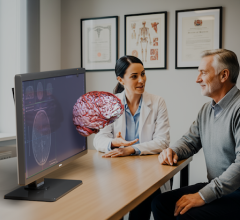
Greg Freiherr has reported on developments in radiology since 1983. He runs the consulting service, The Freiherr Group.
MR is About to Get Faster, Cheaper and More Valuable: It's About Time

Advances promise to make MR heart scans routine. (Graphic courtesy GE Healthcare)
It’s been almost 40 years since the first human magnetic resonance (MR) pictures were taken. Along with decades of experience we’ve seen the development of custom sequencing and mind-boggling advances in computer processing. Yet there has been virtually no change in the length of exams.
I was at a loss to explain it to my son a couple weeks ago, when he asked me why it took an hour to scan his shoulders. Before putting in the earplugs to guard against the other worldly noises of MR, he was coached by the technologist to stay as still as he could. Movement, he was told, might result in the need for a retake.
He spent an hour in that cylinder, about the same exam time for patients in the 1980s. I received a second dose of déjà vu when the summary of charges arrived. When my wife me asked me to guess, being something of a cynic, I price it at what I thought was the high-end — $2,500 maybe. I was 300% too low.
There is an old saying that work expands to fill the time available for its doing. Another dictates that prices will rise to whatever the market will bear. If these are the reasons why my son’s MR exam took an hour and were charged north of $7,000, MR providers are going to be in for a big surprise.
The idea of allocating one-hour slots for individual patients is nearing the end of its lifetime. If historic trends continue, MR procedure volume will increase not only for traditional central nervous system (CNS) applications but on the heels of advancing clinical capabilities. Breath-hold scanning without respiratory gating has flung wide the door to routine abdominal imaging, including the liver — a possibility now being explored as part of a multi-site clinical study sponsored by the National Institutes of Health (NIH). A new MR algorithm produces images that rival those of CT (See “RSNA Technology Report 2015: MRI”; 1:20 in the video). And cloud supercomputing of cardiac scan data has raised the possibility that MR heart imaging could be an everyday occurrence (See “RSNA Technology Report 2015: MRI”; 3:30 in the video).
Then there is the financial argument. My son was scanned at 6 pm on a Friday night. The cost of running an MR operation for 12 hours is on a collision course with the tenets of value medicine. Charges of more than $7,000 for a single scan will be intolerable in the near future. (Truth be told, arrangements between the hospital and my insurer shifted over $4,000 in charges back to the provider. Remaining, however, was a $2,600 charge of which our insurer paid the vast majority.)
The time is coming when providers will tire of discounting services more than 60 percent; insurers will balk at picking up even heavily discounted bills; and radiology administrators will refuse to extend schedules and pay overtime for technologists. When they do, MR providers will have to be ready. The good news is that they probably will be.
We are rapidly approaching a time when the underlying processes that run medical imaging scanners will be all but fully automated. Already the medical community has taken strides toward image-enabling the enterprise. This will pave the way to the integration of electronic medical records (EMR) and the workflow engines that drive radiology departments. Exam orders from referring physicians will pass directly to scanners, triggering set protocols in the context of anatomical data and patient history from the EMR. This will establish the basis for decisions, made by MR scanners machine — and instituted under human guidance — as prescribed by best practices that dictate specific MR sequences for handling certain disease and patient types.
The boost in efficiency will be unprecedented.
Exam times will shrink, as set up and scanning are streamlined, and the use of smart algorithms (see “Smart Scanners: Will AI Take the Controls?”) to optimize sequences and the resultant acquisition of data further streamline the process.
Technologists will do what people do best — interact with patients to make their experience as comfortable as possible. No longer will they be placed in the role of warning patients that their movement could result in going through the agonizing process of an MR scan a second time.
If we truly are committed to pursuing patient-centric healthcare, minimizing discomfort by getting the patient out of the MR scanner as quickly as possible has to be a priority. It is unfortunate that it will have taken the prospect of diminishing resources to achieve what should have been a major goal from the very beginning.
Editor’s note: This is the first blog in a series of four by industry consultant Greg Freiherr on MR Balances Speed and Clinical Reach. To read all of Greg's blogs, click here.


 December 15, 2025
December 15, 2025 









